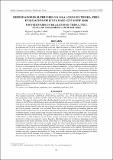Por favor, use este identificador para citar o enlazar este ítem:
https://hdl.handle.net/20.500.12958/3418Registro completo de metadatos
| Campo DC | Valor | Lengua/Idioma |
|---|---|---|
| dc.contributor.author | Aguilar-Arakaki, Regina | - |
| dc.contributor.author | Llapapasca Lloclla, Miguel | - |
| dc.contributor.author | Quiñones Dávila, Javier | - |
| dc.contributor.author | Rivadeneyra Villafuerte, Sofía | - |
| dc.contributor.author | Torres, David | - |
| dc.contributor.editor | Instituto del Mar del Perú | - |
| dc.date.accessioned | 2020-05-19T04:14:42Z | - |
| dc.date.available | 2020-05-19T04:14:42Z | - |
| dc.date.issued | 2020 | - |
| dc.identifier.citation | Inf Inst Mar Perú 47(1), 2020, p. 37-64 | es_ES |
| dc.identifier.issn | 0378-7702 | - |
| dc.identifier.uri | https://hdl.handle.net/20.500.12958/3418 | - |
| dc.description.abstract | Las evaluaciones se realizaron del 20 al 30 de marzo 2014 en la isla Lobos de Tierra (6°25,96’S; 80°52,27’O) ubicada a 11,4 km de la costa. La isla tiene influencia de la corriente fría de Humboldt y la corriente cálido-ecuatorial. Se realizaron censos gráficos, cálculos de áreas de algunas subcolonias con GPS in situ y censos por mar. En tierra las especies de aves más frecuentes fueron camanay, piquero y guanay. Se registraron seis subcolonias reproductivas de camanay y dos de piquero, nueve subcolonias en aposentamiento de piquero y cinco de guanay. Se observaron pequeñas congregaciones de pelícanos reproductivos con pichones en el lado nororiental de la isla. El camanay se encontró en toda la isla iniciando el comportamiento de cortejo. En el censo marino se registraron doce especies, más abundantes fueron guanay y camanay. La mayor abundancia de aves se registró en el lado sur oriental de la isla. Trece de las dieciséis especies registradas están catalogadas al menos en una categoría de amenaza y doce de ellas son residentes y/o reproductivas. La isla no constituye un área reproductiva para la población de lobos chuscos Otaria flavescens. La contaminación tanto por desechos de las actividades de pesca como por ruidos son las principales amenazas encontradas. El número de embarcaciones que se encuentran en los alrededores de la isla podrían perturbar las rutas de migración de las ballenas jorobadas. En esta isla se congregan ejemplares juveniles y subadultos de tortugas verde del Pacífico Oriental (Chelonia mydas agassizii), sobre todo en la parte sureste. La abundancia de tortugas marinas es la más alta (323 tortugas/km2) y está restringida dentro de los 30 – 50 metros de distancia a la orilla (El Ñopo, Ensenada Grande, Tortuga y Ensenadita). Se evidencia mayor concentración (8,5 veces más en la tarde que en la mañana) a partir del mediodía, lo que está relacionado con el incremento de la TSM (>1,5°C) y del ambiente (>6,3°C). | es_ES |
| dc.description.abstract | ABSTRAC: Between 20-30 March 2014, the assessments were conducted on Isla Lobos de Tierra (6°25.96’S, 80°52.27’W), which is located 11.4 km offshore. The island is influenced by the cold Humboldt Current and the warm equatorial current. Graphic census, in situ GPS area calculations of some subcolonies, and sea census were carried out. The most common bird species on the ground were blue-footed booby, Peruvian booby, and guanay cormorant. Six breeding subcolonies of blue-footed booby and two of Peruvian booby, nine roosting subcolonies of Peruvian booby and five of guanay cormorant were recorded. There were small congregations of breeding pelicans with chicks on the northeastern side of the island. The blue-footed booby was found all over the island initiating courtship display. Twelve species were recorded in the marine census, the most abundant ones were guanay cormorant and blue-footed booby. The greatest abundance of birds was recorded on the southeast side of the island. A total of thirteen of the sixteen species recorded are listed in at least one threat category and twelve of these are sedentary and/or breeders. The island does not constitute a breeding area for the population of the South American sea lion Otaria flavescens. Both fishing waste and noise pollution are the main threats identified. The number of vessels around the island could disrupt the migration routes of the humpback whales. Juvenile and sub-adult Eastern Pacific green turtles (Chelonia mydas agassizii) congregate on this island, particularly in the southeast. The abundance of sea turtles is the highest (323 turtles/km2) and is restricted within 30 - 50 meters offshore (El Ñopo, Ensenada Grande, Tortuga, and Ensenadita). From midday onwards, a greater concentration (8.5 times more in the afternoon than in the morning) is evident, which is related to the increase in sea surface (>1.5°C) and environment (>6.3°C) temperatures. | - |
| dc.language.iso | spa | es_ES |
| dc.publisher | Instituto del Mar del Perú | es_ES |
| dc.relation.ispartofseries | Informe IMARPE;47(1), 2020 | - |
| dc.rights | info:eu-repo/semantics/openAccess | es_ES |
| dc.rights.uri | https://creativecommons.org/licenses/by/4.0/ | es_ES |
| dc.source | Instituto del Mar del Perú - IMARPE | es_ES |
| dc.source.uri | Repositorio Digital IMARPE | es_ES |
| dc.subject | Depredadores superiores | es_ES |
| dc.subject | Aves marinas | es_ES |
| dc.subject | Mamíferos marinos | es_ES |
| dc.subject | Quelonios | es_ES |
| dc.subject | Ecosistema marino | es_ES |
| dc.subject | Isla Lobos de Tierra | es_ES |
| dc.title | Depredadores superiores en isla Lobos de Tierra, Perú. Evaluación de Línea Base (GEF–UNDP 2014) | es_ES |
| dc.title.alternative | Top predators on Isla Lobos de Tierra, Peru. Baseline assessment (UNDP-GEF 2014) | es_ES |
| dc.type | info:eu-repo/semantics/article | es_ES |
| Aparece en las colecciones: | Informe vol. 47(1) 2020 | |
Ficheros en este ítem:
| Fichero | Descripción | Tamaño | Formato | |
|---|---|---|---|---|
| Informe 47(1) art 3.pdf | 972,31 kB | Adobe PDF |  Visualizar/Abrir |
Este ítem está sujeto a una licencia Creative Commons Licencia Creative Commons

